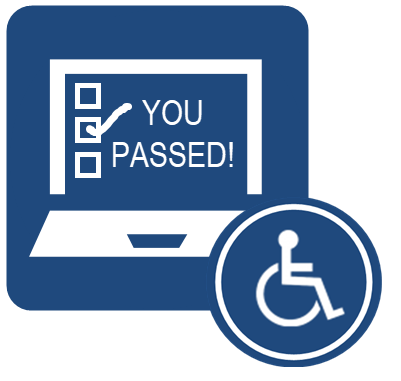Lack of Formative Instruction on the Use of Rubrics for ESL Students in Higher Education
Dania Kazkaz
Introduction
 Higher education institutions rely on rubrics as part of their evaluation methodologies. A rubric is a scoring tool that outlines the exact expectations for an assignment. It breaks down an assignment into its various components and gives a detailed discussion of what makes an acceptable or unacceptable level of performance for each of those parts (Stevens & Levi,
Higher education institutions rely on rubrics as part of their evaluation methodologies. A rubric is a scoring tool that outlines the exact expectations for an assignment. It breaks down an assignment into its various components and gives a detailed discussion of what makes an acceptable or unacceptable level of performance for each of those parts (Stevens & Levi,
2013 as cited in Su, 2020). While rubrics are designed to clarify expectations and promote consistency in grading, students whose first language is not English, also called students with English as a Second Language (ESL students), often face challenges in interpreting the rubrics’ purpose or understanding the language used. In addition, ESL students may hold different cultural expectations around assessment, particularly if they come from an exam-based educational system where evaluation methods are not shared with students. As a result, the educational system must consider the diverse linguistic and cultural backgrounds of all learners to ensure equitable access to learning tools. Providing clear, guided explanations of how to interpret and use rubrics is significantly more effective than simply attaching them to an assignment description. Provide clarification to this evaluation tool not only supports understanding but also enhances student motivation and engagement by removing unnecessary barriers to success. This chapter explores how the lack of clear interpretation of rubrics in higher education presents an accessibility issue for ESL students. It then proposes solutions through the integration of instructional design strategies and the use of appropriate digital teaching and learning resources.
Accessibility Concern
 Providing a rubric as part of an assignment without offering any clarification of its criteria can create barriers for ESL students who are unfamiliar with this type of evaluation tool due to differences in their prior educational experiences or a lack of understanding of certain academic terms. This evaluation method is a Western system and not universally designed, as it is not internationally standardized, and many ESL students may be unfamiliar with its format, as they are used to a style that relies on exams to determine the students’ grade level. When Educators typically create rubrics, and pupils are assumed to understand them (Chan & Ho, 2019), they unintentionally ignoring the diversity in the students’ backgrounds or prior knowledge and assuming that all higher education students, including ESL students, have gone through the western kindergarten to grade twelve (K–12) system, and therefore they have been exposed to the use of rubrics in their educational experiences. This gap in unfamiliarity creates an inequity in understanding the use of this evaluation tool, which can result in lower or unfair grades, increased stress and anxiety, and unequal opportunities for ESL students to demonstrate their knowledge. Balan & Jönsson (2018) state that when unclear goals and vague assessment criteria are presented to students, it may negatively impact their performance, increase anxiety, and reduce their use of self-regulated learning strategies. Specifically, they note that the effective use of rubrics can help decrease a behaviour driven by negative emotions such as anxiety (Panadero & Jönsson, 2013 as cited in Balan & Jönsson, 2018).
Providing a rubric as part of an assignment without offering any clarification of its criteria can create barriers for ESL students who are unfamiliar with this type of evaluation tool due to differences in their prior educational experiences or a lack of understanding of certain academic terms. This evaluation method is a Western system and not universally designed, as it is not internationally standardized, and many ESL students may be unfamiliar with its format, as they are used to a style that relies on exams to determine the students’ grade level. When Educators typically create rubrics, and pupils are assumed to understand them (Chan & Ho, 2019), they unintentionally ignoring the diversity in the students’ backgrounds or prior knowledge and assuming that all higher education students, including ESL students, have gone through the western kindergarten to grade twelve (K–12) system, and therefore they have been exposed to the use of rubrics in their educational experiences. This gap in unfamiliarity creates an inequity in understanding the use of this evaluation tool, which can result in lower or unfair grades, increased stress and anxiety, and unequal opportunities for ESL students to demonstrate their knowledge. Balan & Jönsson (2018) state that when unclear goals and vague assessment criteria are presented to students, it may negatively impact their performance, increase anxiety, and reduce their use of self-regulated learning strategies. Specifically, they note that the effective use of rubrics can help decrease a behaviour driven by negative emotions such as anxiety (Panadero & Jönsson, 2013 as cited in Balan & Jönsson, 2018).
Not providing an explanation for rubric expectations is not currently a direct violation of the Accessibility for Ontarians with Disabilities Act (AODA), as the existing standards do not explicitly address a lack of understanding of evaluation tools as a form of non-compliance. However, educators may unintentionally create barriers for students who need more clarification by failing to describe an evaluation tool. One of the two committees established to recommend what an education accessibility standard should include has been tasked with identifying barriers faced by students in colleges and universities (AODA.ca, 2025). These recommendations aim to improve accessibility, which may include addressing communication barriers such as unexplained evaluation methods.
Another important consideration is that failing to explain rubrics to ESL students can go against Equity, Diversity, and Inclusion (EDI) principles. Equity in higher education prompts institutions to help break down systemic obstacles to access and ensure that various voices and viewpoints are meaningfully reflected in the planning process (Rossi & Brischetto, 2024). That means ensuring that all students, regardless of their background, have access to the resources and opportunities they require for success (Ayeni & Eden, 2024 as cited in Naim, 2025). This approach acknowledges that students do not begin from the same starting point and that systemic barriers may affect some learners more than others. This includes assessment practices, such as the design and delivery of rubrics, which must be clear and inclusive for all learners. For ESL students, the lack of clear interpretation of rubric criteria can pose a significant barrier to achieving equitable outcomes, as it limits their ability to understand performance expectations and demonstrate their learning effectively. Diversity is a core value of any academic or cultural organization. In the context of design education, diversity entails considering the cultural, social, psychophysical, and economic disparities between the end users who will interact with and benefit from the produced solutions (Rossi & Brischetto, 2024). For ESL students, when rubric requirements are offered without clear direction or in culturally unfamiliar formats, they may be at a disadvantage, unable to properly demonstrate their knowledge and meet expectations.. Finally, inclusion considers both cultural and design aspects. It is often viewed as a goal that requires careful and purposeful design interventions to guarantee that all individuals feel represented, respected, and empowered in educational and design settings (Rossi & Brischetto, 2024). Which means that all learners, not only the majority, should see themselves represented and valued in the educational plan. Rubrics are rooted in western educational practices, which emphasize transparency and detailed evaluation criteria. ESL students, particularly those from eastern educational backgrounds, may be unfamiliar with this approach. In many eastern systems, assignments are often based on high-pressure exams where students provide extensive answers, and the evaluation criteria remain known only to the teacher. This contrast can create confusion and disadvantage ESL students who are not accustomed to self-guided performance expectations. Without explicit explanation, they may misunderstand the purpose or weight of rubric criteria, leading to unfair assessment outcomes. Moreover, the equity theory supports the focus on interventions such as inclusive teaching, which try to meet the individual needs of marginalized students rather than using a one-size-fits-all approach. (Weuffen et al., 2023a,b as cited in Naim, 2025) to ensure all students feel represented, respected, and empowered in their learning.
Instructional Design Solution
 There are many strategies educators can incorporate into their teaching plans to help overcome obstacles that may prevent ESL students from effectively demonstrating their abilities.
There are many strategies educators can incorporate into their teaching plans to help overcome obstacles that may prevent ESL students from effectively demonstrating their abilities.
Support the development of teachers’ knowledge of language via training and professional development (Gonsalves, 2023) so educators can provide a clear language of rubric expectations, as wording can sometimes confuse ESL students or make it challenging for them to identify the specific purpose of the evaluation criteria and that will affect their motivation for learning because understanding learning goals and performance requirements improves students’ motivation to learn (Ellis & Tod, 2015 as cited in Balan & Jönsson, 2018). AODA states that educators must learn to educate in ways that meet the requirements for students with various disabilities (AODA.ca, 2025). As a result, the AODA should consider the barriers in achieving fair outcomes, regardless of their origin, as disabilities, and mandate institutions to address systemic and instructional challenges that may disadvantage certain student groups, such as ESL students. This includes ensuring that instructional materials, assessment tools, and methods of communication are designed to be accessible, easy to understand, and inclusive of all learners’ needs. As a result, the AODA requires that all educators receive accessibility training on how to develop accessible courses and classes.
Distinguishing a rubric from an assignment description by comparing it to a more familiar practice (Allen & Tanner, 2006) is a valuable strategy for educators to add to their teaching plan. A checklist can serve as a scaffolding tool that breaks down complex concepts into smaller, more understandable parts. When a checklist is used to introduce rubric criteria, it can help ESL students simplify the language of the rubric and develop a clearer understanding of each criterion. This approach aligns with the Universal Design for Learning (UDL) (CAST, 2025) principle of providing multiple means of engagement by designing instruction to optimize both challenge and support, which is essential for creating an inclusive learning environment. It is important to embed a variety of tools, resources, and supports to help learners successfully engage with learning goals and to ensure they encounter challenges that are appropriately motivating. Establishing a balance between available supports and the level of challenge is crucial, as productive struggle plays a key role in fostering an engaging and rigorous learning experience (CAST, 2024). To illustrate, when educators communicate their expectations for writing a lab report, they can begin by listing the qualities of an excellent report; this provides students with a clear guide for what is expected. By turning these expectations into a checklist, for example, using yes or no boxes to indicate whether specific requirements have been met, educators introduce a simplified version of a rubric. Such checklists share core features with rubrics, such as defined criteria and performance indicators, making them a solid starting point for helping students understand how their work will be evaluated. This approach is particularly helpful for ESL students, as it gradually builds familiarity with rubric language and structure.
Guiding students through rubric training, which involves teaching them to understand the rubric criteria and develop the skills to apply those criteria when completing actual tasks (Su, 2020), that aligns with all three core UDL principles by clarifying expectations under the multiple means of engagement principles design options for sustaining effort and persistence which refers to the importance of clarifying the meaning and purpose of the goal and consistently reinforcing it to the learners through the learning process (CAST, 2024). Moreover, reducing linguistic barriers to understanding the material by offering the design option for language and symbols under multiple means of representation principles. In addition to promoting self-directed learning by offering regular, formative feedback related to the final goal, under the multiple means of action and expression principles. Guiding students through rubric training supports inclusion by ensuring that all learners, not just those already familiar with academic assessment norms, have equal access to success through controlling their choices, planning effectively, making informed decisions, and tracking and evaluating their progress across a variety of linguistic tasks (Su, 2020).
Digital Tools Solutions
 Educators can incorporate tools into their lesson plans to simplify the rubric language and help students better comprehend its criteria. Educators can utilize the following tools:
Educators can incorporate tools into their lesson plans to simplify the rubric language and help students better comprehend its criteria. Educators can utilize the following tools:
Rewordify
Rewordify (n.d.) is a powerful and free online tool that enhances reading, learning, and teaching by simplifying academic content into more accessible English. As a result, ESL students can use it to break down complex rubric language into clearer, more understandable terms. For example, the rubric criteria “Text is on target and brings in more than one perspective to bear on the analysis or descriptions” (Power, 2025) can be reworded into “text that is on target and brings in more than one (way of seeing things what is and is not important) to bear on the analysis or descriptions” (Rewordify, n.d.) by using the rewordify software.
Padlet or Jamboard for Rubric Discussion
Educators can help students comprehend evaluation criteria by using collaborative digital tools like Padlet (n.d.) or Jamboard (Google, n.d.). By sharing a board with the class, educators may help students break down the rubric requirements into simpler, more student-friendly language. This interactive method not only improves understanding but also increases student ownership and engagement in the learning process. It enables learners, particularly ESL students or those unfamiliar with rubric-based evaluation, to ask questions, provide interpretations, and co-create meaning in a supportive environment. This collaborative clarification ensures that all students have equal access to the expectations and are better prepared to meet them.
Digital Infographics
Educators can use digital infographics as a visual learning tool to help students comprehend rubric requirements. The infographic may make abstract or complex expectations more practical and accessible by including explicit examples, icons, and images associated with each condition. This technique is especially beneficial for visual learners, ESL students, and students with learning disabilities since it lowers reliance on heavy academic language while increasing comprehension through many modes of representation. Furthermore, digital infographics are easily shared online, allowing students to review the information at their own pace, reinforcing clarity and promoting independent learning.
Gamification Tools like Kahoot!
Kahoot! (2025) is a game-based learning platform that allows instructors to create interactive quizzes and activities that assess and reinforce student comprehension in an engaging and stress-free setting. By using Kahoot!, educators can create games that assess students’ understanding of rubric language and criteria. Educators can help students become comfortable with crucial criteria by converting abstract evaluative phrases into multiple-choice or matching problems before they are required to apply them in their own academic work. This technique promotes learning through repetition, instant feedback, and active engagement, which is especially useful for ESL students who are unfamiliar with rubric-based examinations. It also fosters a more inclusive classroom climate by making formative assessment enjoyable.
Conclusion
Understanding rubric criteria can be especially challenging for students unfamiliar with this type of evaluation, such as ESL learners who may come from exam-based educational systems. Therefore, clearly explaining the specific purpose of each rubric criterion is essential. It helps students distinguish between task instructions and the criteria by which their work will be assessed. According to the UDL, adhering to the three core principles, such as simplified language, visual tools, or collaborative activities, can support students in accessing and understanding evaluative content, and scaffolding rubric comprehension builds learner confidence, engagement, and success. Furthermore, in line with AODA’s Information and Communication Standards, educators have a responsibility to ensure that all students, regardless of language background or learning need, can understand how their performance will be evaluated. By proactively addressing these barriers, educators foster a more inclusive and equitable learning environment, allowing all students to focus on demonstrating their knowledge without unnecessary obstacles.
References
Allen, D., & Tanner, K. (2006). Rubrics: Tools for Making Learning Goals and Evaluation Criteria Explicit for Both Teachers and Learners. CBE Life Sciences Education, 5(3), 197–203. https://doi.org/10.1187/cbe.06-06-0168
AODA.ca. (2025). AODA requirements for educational institutions. https://www.aoda.ca/aoda-requirements-for-educational-institutions/
Balan, A., & Jönsson, A. (2018). Increased Explicitness of Assessment Criteria: Effects on Student Motivation and Performance. Frontiers in Education (Lausanne), 3, Article 81. https://doi.org/10.3389/feduc.2018.00081 .
CAST (2025). Optimize challenge and support [Consideration 8.2]. In Universal Design for Learning Guidelines version 3.0. https://udlguidelines.cast.org/engagement/effort-persistence/challenge-support
Chan, Z., & Ho, S. (2019). Good and bad practices in rubrics: the perspectives of students and educators. Assessment and Evaluation in Higher Education, 44(4), 533–545. https://doi.org/10.1080/02602938.2018.1522528
Gonsalves, C. (2023). Knowledge of Language in Rubric Design: A Systemic Functional Linguistics Perspective. In Improving Learning Through Assessment Rubrics: Student Awareness of What and How They Learn (pp. 190–211). IGI Global. https://library.oapen.org/bitstream/handle/20.500.12657/88267/9781668460870.pdf?sequence=1#page=223
Google Workspace. (n.d.). Jamboard. https://workspace.google.com/intl/en_uk/products/jamboard/
Kahoot! (n.d.). Kahoot!. https://kahoot.com/
Naim, A. (2025). Equity across the educational spectrum: innovations in educational access crosswise all levels. Frontiers in Education (Lausanne), 9, Article 1499642. https://doi.org/10.3389/feduc.2024.1499642
Padlet. (n.d.). Padlet. https://padlet.com/
Power, R. (2025). Assignment #2, Critical Analysis of an Accessibility Issue and Potential Instructional Design and Digital Resource Solutions [Assignment description]. Ontario Tech University. https://learn.ontariotechu.ca/login
Rewordify (n.d.). Rewordify [Web tool]. https://rewordify.com/
Rossi, E., & Brischetto, A. (2024). Contribution of the ‘Equality, Diversity, and Inclusion’ Concept to Design Education: A Systematic Literature Review. Sustainability, 16(19), Article 8478. https://doi.org/10.3390/su16198478
Su, W. (2020). Exploring how rubric training influences students’ assessment and awareness of interpreting. Language Awareness, 29(2), 178–196. https://doi.org/10.1080/09658416.2020.1743713
